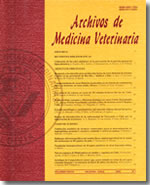Tomografía computarizada de la laringe en perros mesocefálicos
Contenido principal del artículo
Resumen
El objetivo de este trabajo fue describir mediante tomografía computarizada (TC) la anatomía normal de la laringe y sus estructuras anexas en perros mesocéfalos y además correlacionar las imágenes obtenidas con cortes anatómicos. Para ello se utilizaron dos perros adultos sin signos de alteraciones respiratorias con pesos de 12,8 a 18,5 kg respectivamente. En ambos animales se obtuvieron imágenes de TC a nivel de la laringe, bajo anestesia general y con los animales posicionados en decúbito dorsal. Los parámetros técnicos incluyeron imágenes de 3 mm de grosor y 2 mm de intervalo y utilizando una ventana para tejidos blandos. Posteriormente las imágenes obtenidas fueron correlacionadas con secciones anatómicas. La cavidad central de la laringe que incluye el vestíbulo laríngeo, glotis y cavidad infraglótica fue observada como un área hipodensa en todas las imágenes. Otros espacios también identificados incluyeron los recesos piriformes, la vallécula epiglótica y los ventrículos laríngeos. Los cartílagos tiroides y cricoides fueron claramente distinguidos como estructuras lineares hiperdensas, mientras que los cartílagos aritenoideos no se observaron nítidamente debido a la poca calcificación de estos cartílagos observada en los perros. La epiglotis fue identificada como una estructura central cóncava e isodensa. Los resultados obtenidos indican que la TC es un excelente método para evaluación imagenológica de la compleja anatomía de la laringe en perros.

